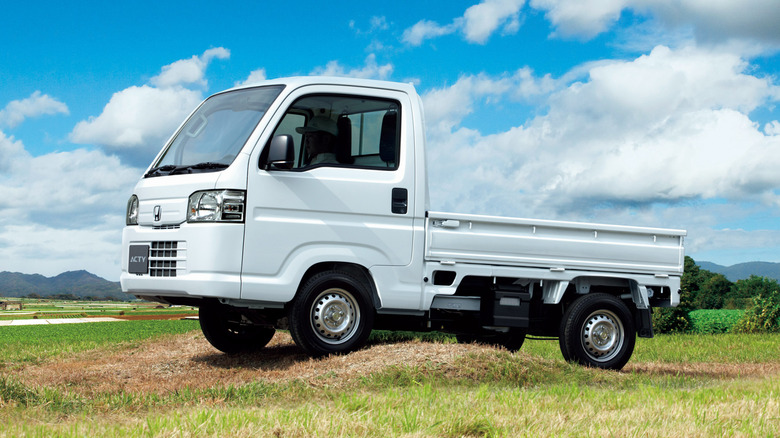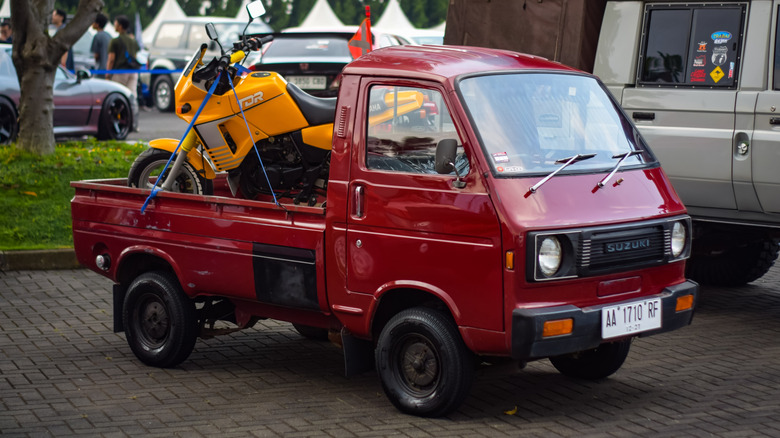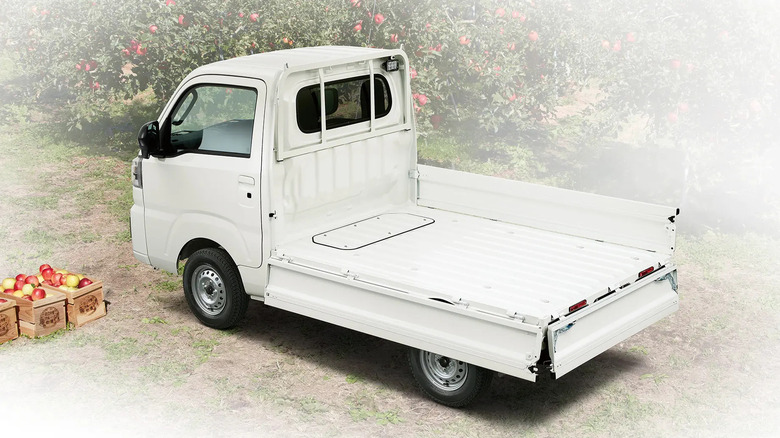How Much Weight Can A Kei Truck Carry?
With most pickup trucks today boasting immense proportions and costing more than ever before, many individuals and small business owners instead opt for something far handier: The kei truck. These miniature sized pickups appear more akin to toys at first glance, their proportions dictated by the Japanese keijidosha size and engine displacement restrictions. These rules effectively limit a kei truck to about 134 inches long, around 58 inches wide, and around 79 inches tall, with a 660cc engine. While there's no strict law governing the engine's total output, all modern kei cars abide by the 64-horsepower gentleman's agreement, meaning there are no factory kei trucks over this limit. All this results in a boxy two-seater pickup with a bed that seems paltry in comparison to most modern American pickups. They couldn't possibly hold that much, right?
In actuality, kei trucks are remarkable haulers. Their towing capacity varies depending on the truck's curb weight, calculated by the formula: Vehicle weight + 55 kg (around 120 lbs) x 2. So a typical 1,900-pound example is rated to tow about 1,000 pounds.
Of course, these numbers merely represent the vehicle's maximum rated carry capacity. In reality, kei trucks can haul more than two times that at speeds of around 45 mph, though they weren't designed with this capacity in mind, and may pose safety hazards if driven with that load. Let's dive deeper and explore the real-world remarkable capabilities of these unassuming trucks.
Realistic cargo capacity and overloading risks
It's one thing to overload a kei truck, it's another to actually drive it. An extreme example of this is demonstrated by superspeedersRob in his video, where he overloads a Daihatsu Hijet with over a ton of cinderblocks. The suspension effectively collapses under the weight, with the shocks regularly bottoming out during regular driving. The kei truck was perfectly able to maintain a constant speed despite its horsepower output, though high-speed driving with such an overloaded truck is asking for trouble.
Japan houses strict regulations governing maximum cargo capacity and overloading, similar to American systems regarding a vehicle's Gross Vehicle Weight Rating (GVWR). This capacity is set strictly at 350kg, or about 770 pounds, with increasing penalties applied to individuals, their businesses, and shipping companies based on the percentage it's overloaded.
The reason why overloading is such a poor idea is because of the inherent safety risks it poses. These include increased braking distance, poor corner handling, a higher center of gravity making it easier to tip over, and more force transferred in a collision. Overloaded cargo may crush a cab if it suddenly stopped in an accident, for instance. Additionally, it overstresses and prematurely wears running-gear components, the truck's chassis, and deteriorates its fuel economy. As such, practically-speaking, the 770-pound weight limit represents the true maximum safe limit, despite the truck's ability to move with over double that capacity.
Practical usage of a cargo-laden kei truck
While at first glance a kei truck appears diminutive, with lower payload capacity than any American pickup, its strengths instead lay in its ability to carry those payloads efficiently and reliably. As such, kei trucks excel at delivering several smaller loads over all types of terrain, especially in cities, off-road backroads, and other tight spaces that maximize their size advantage. The average kei truck typically reaches about 40 MPG or more on average, depending on the cargo weight and size. Their 660cc engines are generally as reliable as you can expect from any 25-year-old pickup. Provided you do the maintenance, this makes trucks like the Honda Acty a solid choice if you're shopping for an affordable Japanese kei car.
Moreover, these trucks boast outstanding volumetric capacity for their relative size, with the typical full-size bed around or over 6 feet long. By comparison, a brand new Ford Maverick compact pickup features a 54.4-inch long cargo bed, about 4.5 feet. This makes kei trucks capable of hauling larger goods, such as furniture, packaged items, and more. Their bed length also provides a highly versatile platform for aftermarket and specialized add-ons, such as firefighting equipment — a task well suited to a vehicle that fits in tight confines. Other kei truck bed types include the enclosed box van and container variants, tow trucks, tipping dump trucks, and scissor lifts, to name several. The bed sides and tailgate also fold down, so most standard-bed kei trucks also double as flatbeds.


